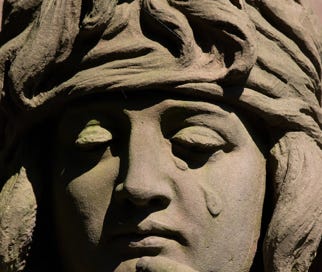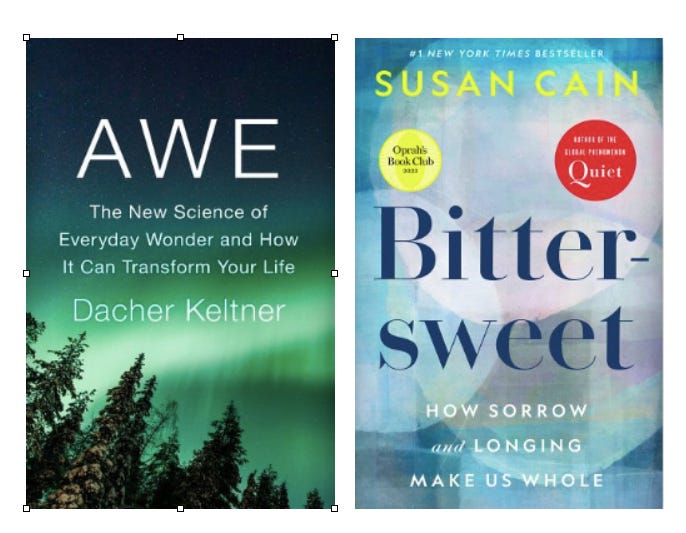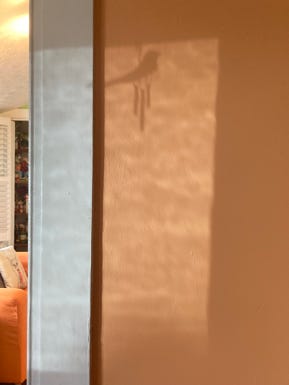Before we begin
Think about those moments you have found yourself in awe. What were you doing? How did you feel? Have you ever shared those moments with others? What experiences fill you with awe? Give you goosebumps? Make you reach for that tissue?
Welcome! You’ve reached Spark. Learn more here or just read on. If you received this from a friend, please join us by subscribing. It’s free! All you have to do is press the button below. If you have already subscribed, welcome back! BTW, if this email looks truncated in your inbox, just click through now so you can read it all in one go.
Meet Robyn Ryle
Occasionally thoughts gather together like tumbleweeds; our individual musings find another’s and perhaps another’s until we just have to talk about it. I’ve been salting away random thoughts about the concept of community, struggling with what it means in today’s increasingly polarized world. Turns out, Robyn Ryle, publisher of You Think Too Much, has been giving it a lot of thought as well. We decided to collaborate and bring the discussion to you for your perspective. Robyn will take over this week’s Spark as guest host and I will offer my thoughts next week on You Think Too Much. Don’t worry, you won’t miss it because I will send out a brief message to you all when it goes live.
If you don’t already know Robyn, waste no time checking out her writing over at You Think Too Much (which, by the way, is exactly what people have said to me my whole life so maybe that’s why I gravitated to Robyn). She is a sociologist, the author of two award-winning books on gender, and teaches college students in southern Indiana where she lives in a small, historic town. She has written for numerous publications and gives talks around the country about place-making and community.
Here’s what she wrote when a book by Berkeley psychologist Decher Keltner got her thinking about the connections forged in those everyday moments of awe. I loved it so much I asked if I could share it here. Take a look and I’ll join you in the comments section. - Betsy
Tears, goosebumps and awe or how much we really do need each other
By Robyn Ryle
When I hear a good ghost story, my eyes tear up. I’ve never really understood why. I don’t really believe in ghosts. I don’t not believe in them, either. But scary or not, I almost always get a little teary.
Other things that make me tear up? Weddings. The fourth of July parade in Madison (I know, embarrassing, and yet). Sappy commercials. The series finale of Buffy the Vampire Slayer. Sports triumph stories. Or a story I just read about the first time Beethoven’s, “Ode to Joy,” was ever played for an audience.
While he was composing, “Ode to Joy,” Beethoven was in a bad way. Deaf. Mourning the death of his nephew, Karl. Lonely, because his deafness made it hard to socialize.
On the day of the performance, Beethoven stood before the symphony, forlorn and disheveled. He made the gestures of a madman and the musicians weren’t sure what he was trying to convey. They played the new piece. Beethoven stood on the stage, his back to the audience, lost inside the music in his head. He didn’t know when the song was done. One of the musicians had to take him by the shoulders and gently turn him around.
There he saw the audience, on their feet, waving their hats and gesturing wildly so that Beethoven, who could not hear their applause or shouts or whistles, would know their approval. So he could see what he had created—joy.
This story made me tear up when I read it in Susan Cain’s book, Bittersweet. Why?
I listened to an interview this week with Dacher Keltner, a positive psychologist with a new book about the power of awe. One of the top awe-inducing experiences for people, around the world? Other people. Acts of bravery or compassion fill us with awe. As do experiences of collective effervescence, that bubbly joy that comes with being together with other human beings. Nature is a big source of awe, too, but the top-two awe-inducing experiences are other people.
Experiences of awe have all kinds of benefits for our mental and physical health, so we should all be seeking out awe. Keltner goes on awe walks, where he purposefully pays attention to the awe-inspiring in the every day. A butterfly in February. An old man petting his dog. Old women having their hair done in the beauty shop—the intimacy and kindness of that act. People taking care of each other often fills me with awe.
Awe is an emotion that pulls us out of ourselves. Literally. The me-centered parts of our brain slow down when we experience awe.
What does that have to do with tears and goosebumps? At the very end of the podcast, Keltner explains that strong emotions give us goosebumps—emotions like awe. The phenomenon of goosebumps is the same phenomenon that makes your cat bristle up if you sneak up on them or they’re hissing at another cat invading their space. We don’t have fur like cats or dogs anymore, but what hair we have is standing on end when we get goosebumps.
In mammalian evolution, we would fluff up our fur so we could huddle together for warmth and safety in the face of threats. Goosebumps are connected to those experiences of community and connection. Primatologist Jane Goodall observed the goosebump phenomenon in apes when they looked at a waterfall. We’re hard-wired for awe and awe is about connection to something bigger than ourselves.
And tearing up? Of course, we cry when we’re angry or sad. But that unique feeling of tearing up at a wedding or a parade or a sappy commercial or when Buffy shares her power with all the other potentials or a story about Beethoven or ghost stories? Research shows what those experiences tend to have in common is community. We cry when we see people forming community. Or reinforcing community. When the audience responds to Beethoven’s symphony. When a ghost story suggests that even after death, maybe we’re not alone. What moves us most frequently are our attempts to bridge the great, lonely divide between us.
Which makes me tear up just a little bit.
Postscript
The same day I wrote this, I read this essay about the effect of smartphones on kids’ health (mental, but I think it has to be physical, too, because it’s all the same thing). Check it out if you’re interested, but there’s a suggestion that things like teen pregnancy, teen car accidents and bullying are down. Good news, but it’s mostly because all those things require teens to leave the house (well, except for cyber bullying) and they don’t as much anymore. So, good, but also, sad?
It got me thinking that we may have all forgotten how to form community and connection or never learned in the first place. I have lots of thoughts on this topic, but wondered what you think?
How do you go about forming community and connection? What makes it easier? If you could break it down into baby steps, what would it look like? So let me have it—how do you make community?
The Books
Awe: The New Science of Everyday Wonder and How It Can Transform Your Life by Dacher Keltner
Bittersweet: How Sorrow and Longing Make Us Whole by Susan Cain
Spark is Yours: Chime In
Hi there, this is Betsy again. Have you just finished a book you loved? Tell us about it. Got a great resource for readers or writers? Share away! How about sharing your book stack with us, that tower of tomes rising next to your bed or your bath or wherever you keep the books you intend to read – someday. And if you stumbled on a Moment of Zen, show us what moved you, made you laugh, or just created a sliver of light in an otherwise murky world.
Thank you and Welcome
Thank you to everyone who has shared Spark with a friend. Please keep it going! We are growing every week and it’s exciting.
Welcome to all new subscribers! Thank you so much for being here. If you would like to check out past issues, here’s a quick link to the archives. Be sure to check out our Resources for Readers and Writers too.
That’s it for this week. Let me know how you are and what you’re thinking about. And of course, always let me know what you’re reading. If there’s an idea, book, or question you’d like to see in an upcoming issue of Spark, let us know! Check out the Moment of Zen Robyn offers this week. It’s a beauty.
Remember, If you like what you see or it resonates with you, please share Spark with a friend and take a minute to click the heart ❤️ below - it helps more folks to find us!
Ciao for now!
Gratefully,
Betsy
P.S. And now, your moment of Zen…Borrowed Light
I live in a historic town (in fact, Madison’s historic district is the largest contiguous national historic landmark in the United States, not to brag), which means all our buildings are much closer together than you’d get in a lot of other small towns. That’s just how they built things in the 19th century. I share a wall with my neighbor, as do a lot of buildings in Madison. There’s a street of row houses that might make you think you’ve landed in Philadelphia.
Living close together like this has its advantages and disadvantages. Natural light comes at a premium if you have buildings on both sides. Luckily, our house sits next to a church. The church is painted white, which means we get a lot of reflective light. In this picture, you can see some of that reflected light through the window and the shadow of a little bird wind chime that hangs there.
Of course, the church didn’t paint their building white for our benefit. That’s just the color most churches are. Still, as often as I can, I make myself stop and appreciate the soft glow of our house is in the mornings, even though the sun never shines directly through our windows that time of day. We turn our lights on only on the cloudy days. We move through our days in borrowed brightness. It’s an unexpected gift that comes precisely from our proximity, a reminder of the light that shines into our lives from unexpected places. - Robyn
Calling for Your Contribution to A Moment of Zen
What is YOUR moment of Zen? Send me your photos, a video, a drawing, a song, a poem, or anything with a visual that moved you, thrilled you, calmed you. Or just cracked you up. This feature is wide open for your own personal interpretation.
Come on, go through your photos, your memories or just keep your eyes and ears to the ground and then share. Send your photos/links, etc. to me by replying to this email or simply by sending to: elizabethmarro@substack.com. The main guidelines are probably already obvious: don’t hurt anyone -- don’t send anything that violates the privacy of someone you love or even someone you hate, don’t send anything divisive, or aimed at disparaging others. Our Zen moments are to help us connect, to bond, to learn, to wonder, to share -- to escape the world for a little bit and return refreshed.
And remember,If you like what you see or it resonates with you, please share Spark with a friend and take a minute to click the heart ❤️ below - it helps more folks to find us!







Building community is a big part (I could almost say the only part, if we weren't also trying to open people up to the Buddha's love!) of running the temple here. We've run book groups for 8 months now and the format is you comment on what OTHER people thought of the chapter - what you liked about what they said, what helped you learn. It really builds fond connections between people. We all want to be appreciated so much, I think! Thank you for your piece both!
Hi Robyn and Betsy, I like this cross post. Robyn, I lived and taught in Madison for two years, loved it, and some of our dear family is still there. Also, I wrote a piece about my Zumba community and I also referenced Buffy- 🤣
As a teacher, building community is key. My students are doing book clubs right now and before they can have hard conversations about the book, they need to connect with each other. I help support this by organizing team building exercises like who can build the tallest tower out of paper and having them play games with one another. Now that we are a few weeks in...some groups prefer to jump right into the conversations about the book. In a time, where lots of folks seem to be freaking out about what is taught in schools, I am so proud that we are teaching kids how to dialogue rather than debate how to converse rather than argue. They do it better than most adults and it is hopeful.
This week I’m reflecting on what Audre Lorde said about community. I’m hoping to write about it in more depth sometime soon. “Difference is needed for community, community is collective power, collective power is needed for liberation, liberation is the celebration of difference. Some may think that different is counter productive when building community…”
Community is not about ignoring difference but rather embracing it and learning the ways that we can connect.